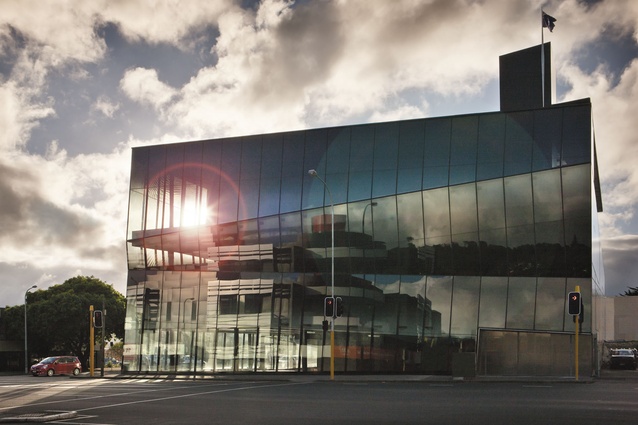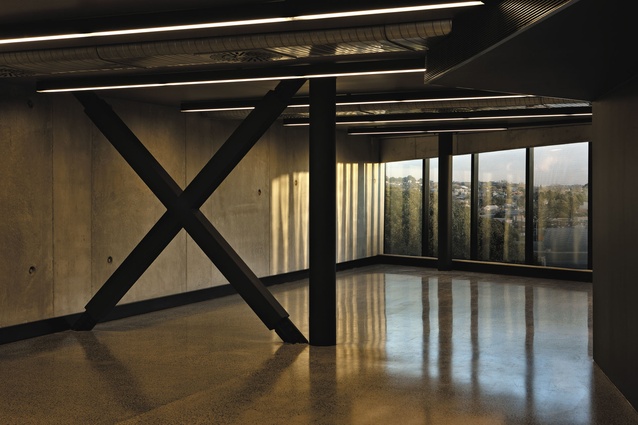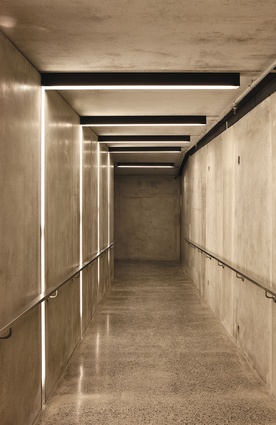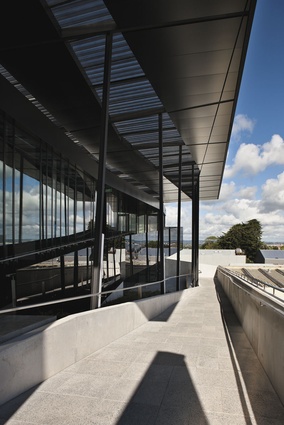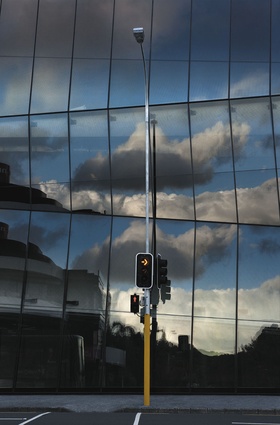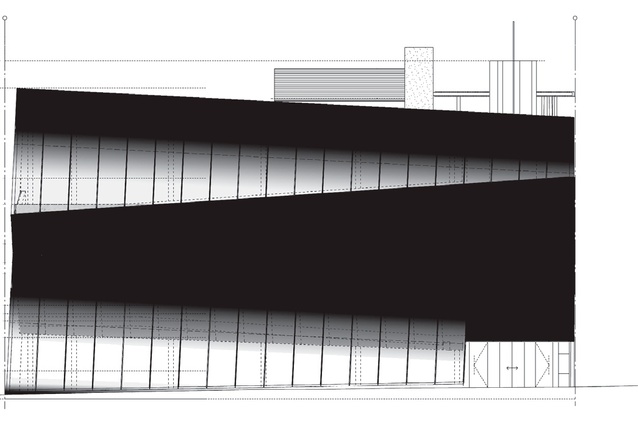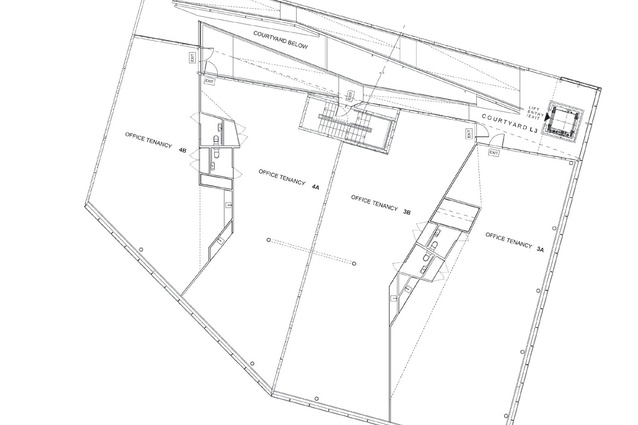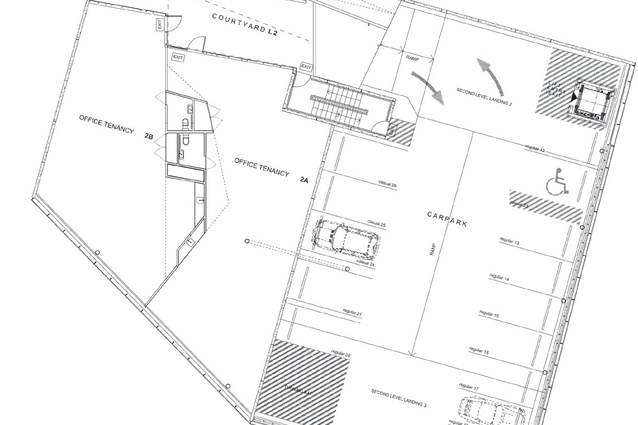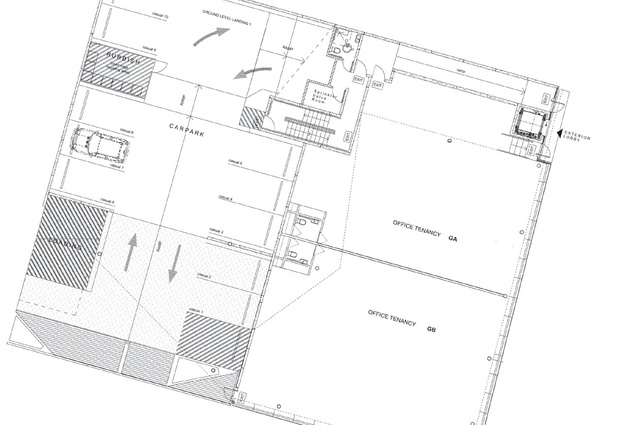Anvil building by Patterson Associates
Sited on volcanic rock, Patterson’s exhilarating Anvil building breathes life into a troublesome city-fringe location.
The city end of Auckland’s Dominion Road has been problematic for as long as I can remember. Developers call spots like this city fringe; it’s the place where cars cross the moat of motorway that encircles the CBD, a bland hinterland of dumb boxes where the only thought that springs to mind is whether you speed up or slow down as your car catapults towards the suburbs off the New North Road interchange. As we’ve been whizzing by the View Road intersection over the past two years, a new development has been spiralling skywards on a former used-car lot.
You can’t dig down into the volcanic rock round here so the building erupts out of the ground: an uneasy stack, a coiled spring. A long spiral carries cars up the first few storeys and is then continued in pedestrian ramps that feed another two floors of tenancies. This vortex is clearly expressed behind the glass skin giving the building a dynamic, restless presence that suits its location on one of the city’s main arteries.
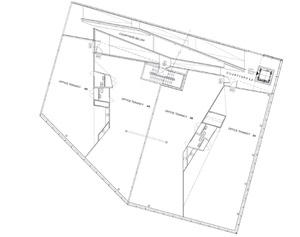
This building is another of architect Andrew Patterson’s medium-sized commercial developments that use cloud forms as conceptual drivers. Patterson explained that this is not just a simplistic reference to Aotearoa but has deeper resonances such as in the Maori creation myth of Ranginui and Papatuanuku, which sees the world of people and nature formed in the space between sky father and earth mother. Patterson has picked up on Polynesian design in a number of buildings: not least D-72 over the road with its woven metallic frontage. He sees these references in his works not just as badges of regional identity, but as ways to align them with a deeper, more-holistic world view.
Anvil is named after the great cumulonimbus storm cloud that also has internal vortices feeding its growth. So it immediately strikes you with its somewhat grumpy and glowering aspect: a big, dark form on the crest of the hill, its billow and spiral channelled into a faceted glass skin. It does seem more reminiscent of the blacksmith’s anvil than the cloud, though it maintains a dark, gem-like translucency due to the colour of the glass and the varying mesh of dots that cage it. Its angular forms and reflectivity create a mirror that makes our Auckland sky seem even more turbulent than usual.
At ground level, there’s a big retail space on the street but no verandah and little sign of the usual entry and lobby you would expect for servicing the upper storeys. This prompts the question: to what extent should architecture tend towards the sculptural and be expressive and reflective of its context. Or should architecture be a tool in urban design strategies, aiming to make good the badlands that modernism, capitalism and traffic engineers have given us on the edges of our city centres. For instance, our planners may not require a verandah here but does that give us licence to get away without that, or do good social manners mean we should aim to architecturally repair the streetscape here? Seemingly as a civic gesture, Anvil sports our national flag on its turret-like lift tower, although this looks a little at odds with its cool minimalism and sculptural purity. It seems more as if some cocky local on the eve of its launch has conquered the structure’s oily, iceberg-like slopes and planted a banner there.
The lift door opens immediately on to the street, like an airlock, snatching you up a couple of floors, delivering you through a back door to a sky courtyard. And it is a different world up here, in what you might call the troposphere. Four tenancies are spread over the top two levels, connected by a couple of ramps under a warm and sunny loggia, oriented north. This aerie provides the kind of combination of circulation and social space that we have seen working well in a few good medium-rise complexes by Patterson Associates and RTA Studio over the last decade. There’s an intimate community ambience, a bit of greenery, a verandah. It is an island in the sky, divorced from the streets, but this may change with development of the block; in future, these aerial lanes could overlook a central courtyard next door.
The variably dotted glass cladding forms a screen that makes you feel slightly contained, separated from the world. Plainly, the architecture and the numbers have worked out for these folks as pretty much everything is leased. The floor plates can be split in two as has happened with one of them, but the bisecting party wall maintains an appropriate sense of torsion through being twisted into a series of shifting planes. The spaces are interesting and funky, suited to the designers and media types that colonise these city-fringe developments, who like a place to park their chariots handy to the motorway.
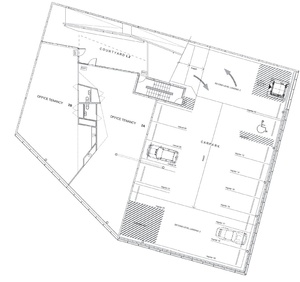
This is a big aircraft carrier of a building – steel and glass, docked alongside Dominion Road, laden with vehicles, crew crowding the upper decks. It makes a good gateway landmark on the intersection, either as we plunge down to enter the suburbs or crest the hill travelling north, preparing to launch over the interchange and hit the city. It is an exhilarating building to both zoom by and be in, but these qualities can be seen to be at the expense of the street level. How is it for Joe Bloggs walking by from the bus stop on a rainy day? I know what’s behind the stainless-steel door but, to the uninitiated, this building can seem brusque and aloof. Perhaps that will change when the ground floor is tenanted, warming up the street front. It will certainly change when the developer, who owns the entire block, has completed its transformation into what I expect will be a more public-friendly courtyarded complex similar to Patterson’s other developments. Then, Anvil will be seen as a suitably solid cornerstone on the bleakest edge of the neighbourhood. ?But, in any case, Anvil remains a vigorous example of architecture that handles well the exigencies of the contemporary, car-focused city’s toughest sites: the city-centre fringe.

